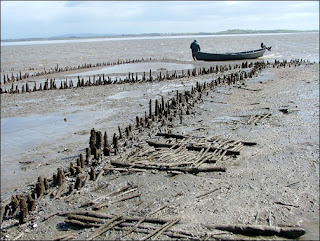Objects made of stone, dated to 6300 – 5990 BC and excavated in houses of the Mesolithic Lepenski vir culture, 9500-5500BC, Danube Iron Gates gorge, eastern Serbia. All have carvings on the surface. Lengths: 35-45cm. Classified as "stone sceptres". But are they?
The other day I came across the article "Big Fish Hunting: interpretation of stone clubs from Lepenski Vir" by Ivana Živaljević.
In this paper, the author proposes that these objects were in fact stone clubs or mallets, which may have been used in fishing as stunners. Not any fish fishing...Sturgeon fishing...
And they are easily caught using fish traps. 19th c. sturgeon traps in the Danube Iron Gates gorge were described as follows: The narrow branches of the Danube are disrupted [by] double post structures made from timber, arranged in a V-shape, opening downstream...
Once the sturgeons enter, it is not their habit to turn downstream. As they proceed in the ever-narrowing funnel, they wind up in the 'death chamber' at the end...” All you need to do then is kill it and drag it out of the water...
Danube Iron Gates gorge is exactly where Mesolithic Lepenski vir settlement was located. We know that people from Lepenski vir were fishermen, judging by the huge number of fish bones found in the settlement, particularly sturgeon bones...
There is no evidence how Lepenski vir people caught sturgeons, but we can assume that they used fish traps used by fishermen world over to catch migratory fish, either in rivers or in tidal seas.
Ivana Živaljević proposes that once sturgeons were stranded inside the "death chamber" at the end of the trap, that they were basically clubbed to death using stone mallets...
Ivana Živaljević says that "The massive and often ornamented stone clubs were initially interpreted as 'magic' and 'ritual' devices; however, it should be noted that the 'ritual' and 'profane' uses of an object need not exclude one another"...
There is one reason why Ivana Živaljević might be right in thinking that maybe these stone objects were both stone mallets used for killing giant sturgeons and sacred sceptres...
One other thing found in many Lepenski vir houses is this: a statue carved out of a large river pebble (boulder). It is believed by many archaeologists that it depicts a human-fish hybrid...And not any fish. A human-sturgeon hybrid...
But also human spinal vertebrae...
Who knows...But there is definitely something fishy going on here...
By the way, did you know that the migration of giant sturgeons up Danube river started every year "as soon as the the snow started melting, and water level started to rise, in late February, early March". In pisces...I talked about pisces as an animal calendar marker for the migration of continental European salmon (now extinct) in my post "Fishes"...
If you have found this interesting, you might find this post interesting too: Sun over pyramid, sun worship in the Lepenski Vir culture...












In general, "Vir" means "whirlwind" in Serbian, or "whirlpool" - a place that has a reputation for being dangerous. It would seem strange to base a settlement in a dangerous place. Initially, it was even assumed that it had a defensive value. But the fact is that "Vir" is dangerous if you don't know how to handle it. A Serbian scientist, Predrag Ristic, showed back in 1970 that if one knows and follows the rules of nature, the whirlpool becomes a kind of tool in the hands of people.
ReplyDeleteThe fact is that if you know the laws of water current, then, skillfully included in the "vortex", you can sail in one direction (for example, for the purpose of fishing), and return in a circle. There is no need for oars, no motor, no sail, and no need to return home on foot, dragging the boat against the current. That is, the "water vortex" would carry the anglers away and bring them back. Professor Ristich has established that there are several such circles, of which the largest has a diameter of about 4 km.
https://44serbia.ru/lepenski-vir-nahodki-i-zagadki/
This is very interesting. Thanks
DeleteHere's the clip: https://youtu.be/ZaZLzfgOMzo?t=281
ReplyDeleteThis is SUPER COOL...Hvala najlepse
Delete